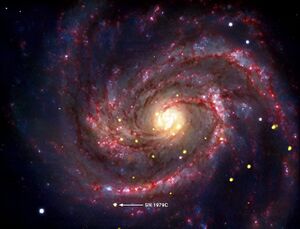Astronomy:SN 1979C
 | |
| Spectral class | Type II[1] |
|---|---|
| Date | 1979 |
| Constellation | Coma Berenices |
| Right ascension | 12h 22m 58.58s |
| Declination | +15° 47′ 52.7″ |
| Epoch | J2000.0 |
| Galactic coordinates | G271.2454 +76.8848 |
| Distance | 50 Mly |
| Remnant | ? |
| Host | M100 |
| Progenitor | ? |
| Progenitor type | ? |
| Colour (B-V) | ? |
| Peak apparent magnitude | +12.23 |
SN 1979C was a supernova about 50 million light-years away in Messier 100, a spiral galaxy in the constellation Coma Berenices. The Type II supernova was discovered April 19, 1979 by Gus Johnson, a school teacher and amateur astronomer.[2] This type of supernova is known as a core collapse and is the result of the internal collapse and violent explosion of a large star. A star must have at least 9 times the mass of the Sun in order to undergo this type of collapse.[3] The star that resulted in this supernova was estimated to be in the range of 20 solar masses.[1]
On November 15, 2010 NASA announced that evidence of a black hole had been detected as a remnant of the supernova explosion. Scientists led by Dr. Dan Patnaude from the Center for Astrophysics | Harvard & Smithsonian in Cambridge, MA evaluated data gathered between 1995 and 2007 from several space based observatories. NASA's Chandra X-ray Observatory, the Swift Gamma-Ray Burst Mission, as well as the European Space Agency's XMM-Newton, and Germany's ROSAT all participated in the examination.[4]
The researchers observed a steady source of X-rays and determined that it was likely that this was material being fed into the object either from the supernova or a binary companion. However, an alternative explanation would be that the X-ray emissions could be from the pulsar wind nebula from a rapidly spinning pulsar, similar to the one in the center of the Crab Nebula.[4] These two ideas account for several types of known X-ray sources. In the case of black holes the material that falls into the black hole emits the X-rays and not the black hole itself. Gas is heated by the fall into the strong gravitational field.
SN 1979C has also been studied in the radio frequency spectrum. A light curve study was performed between 1985 and 1990 using the Very Large Array radio telescope in New Mexico.[5]
See also
References
- ↑ 1.0 1.1 Nancy Atkinson (November 15, 2010). "Has a Recent, Nearby Supernova Become a Baby Black Hole?". Universe Today. http://www.universetoday.com/78836/has-a-recent-nearby-supernova-become-a-baby-black-hole/. Retrieved 2010-11-18.
- ↑ Peter Edmonds (November 16, 2010). "The Man Who Discovered SN 1979C and Beat the Machines". Center for Astrophysics | Harvard & Smithsonian. http://chandra.harvard.edu/chronicle/0410/sn1979c/index.html. Retrieved 2010-11-21.
- ↑ Gilmore, Gerry (2004). "The Short Spectacular Life of a Superstar". Science 304 (5697): 1915–1916. doi:10.1126/science.1100370. PMID 15218132. http://www.sciencemag.org/cgi/content/full/sci;304/5679/1915. Retrieved 2007-05-01.
- ↑ 4.0 4.1 Trent Perrotto; Janet Anderson (Nov 15, 2010). "NASA'S Chandra Finds Youngest Nearby Black Hole". NASA. http://www.nasa.gov/home/hqnews/2010/nov/HQ_10-299_CHANDRA.html. Retrieved 2010-11-15.
- ↑ Weiler, K. W.; van Dyk, S. D.; Discenna, J. L.; Panagia, N.; Sramek, R. A. (1991). "The 10 year radio light curves for SN 1979C". Astrophysical Journal 380: 161–166. doi:10.1086/170571. Bibcode: 1991ApJ...380..161W.
External links
- Light curves and spectra on the Open Supernova Catalog
- SN 1979C in M100
- A Tour of SN 1979C (narration of podcast by Dr. Dan Patnaude)
 |



